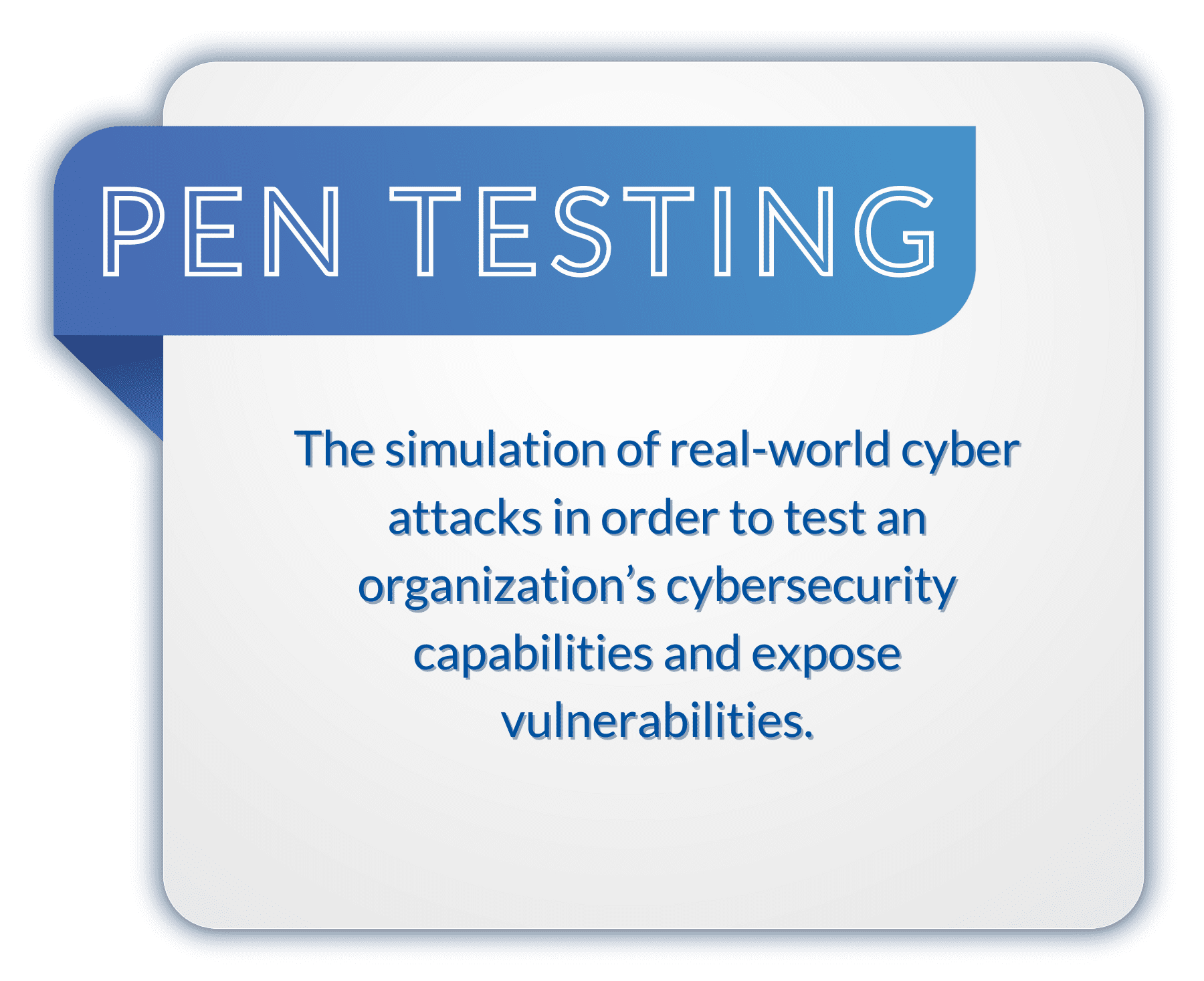
Enhancing your organization’s cybersecurity posture requires a thorough understanding of not only active vulnerabilities, but potential vulnerabilities as well. This is where penetration testing, or pen testing, comes into play – which can be used as a tool to fortify your defenses.
As we delve into the complex world of cybersecurity, it becomes paramount to understand the importance of proactive measures. Here, we’ll shed light on the fundamentals of pen testing, exploring its methodologies, purposes, and the role it plays in safeguarding your digital assets and IT infrastructure.
What Is Pen Testing?
“We need to have a penetration test.”
That is how the conversation usually begins. Not intending to sound philosophical, my response is often, “what does that [penetration test] mean to you?” I ask because most people have different expectations when it comes to penetration testing. If anything, setting and managing realistic expectations is key.
According to CrowdStrike, pen testing is, “The simulation of real-world cyber attacks in order to test an organization’s cybersecurity capabilities and expose vulnerabilities.” Well, that’s much easier said than done. So, where do you start, and what should you take into consideration?
Considerations For A Successful Pen Test
Your Readiness
The first question that needs to be answered is, “Are you even ready for a pen test?” Sometimes, during a call, we find out the client does not have a patching policy, their firewall is not configured to use UTM, or they are otherwise operationally immature. In this scenario, there are so many potential entry points that a pen test is not going to find them all. Conducting a pen test is not a good use of resources.
Not sure if you’re ready for a pen test? Reach out to us and we can help.
Choose Your Starting Point
If you are ready, what should you expect on this journey? Where will the pen test begin? Do you need to perform an external or an internal pen test? Or do we only need to test a web application? Let’s explore the different types of pen testing:
External Pen Testing
Focuses on examining your systems exposed to the Internet. Its goal is to identify exploitable vulnerabilities that could potentially expose data or allow unauthorized access to external entities. The assessment involves tasks such as system identification, enumeration, discovering vulnerabilities, and exploiting them. The thing to remember is an external pen test simulates an attacker with no connection trying to get in from a remote location.
Internal Pen Testing
Evaluate the internal systems of your organization to determine potential lateral movements within your network. This assessment includes activities such as system identification, enumeration, vulnerability identification, exploitation, privilege escalation, lateral movement, and achievement of specified objectives. The genesis of an internal pen test is from the perspective of a compromised computer inside your network, assuming that the starting point is one of your computers taken over by an attacker.
Web Application Pen Testing
Assesses your web application through a three-step procedure. The initial phase involves reconnaissance, during which the team uncovers details such as the operating system and utilized services/resources. Subsequently, in the discovery phase, the team seeks to pinpoint vulnerabilities. The final stage is exploitation, where the team utilizes the identified vulnerabilities to gain unauthorized access to sensitive data.
Wireless Pen Testing
Detects the potential risks and vulnerabilities associated with your wireless network. The team evaluates weaknesses, including but not limited to de-authentication attacks, misconfigurations, session reuse, and the presence of unauthorized wireless devices.
Physical Pen Testing
Recognizes the risks and vulnerabilities impacting your physical security, aiming to access a corporate computer system. The team evaluates weaknesses, covering aspects like social engineering, tailgating, and other objectives related to physical security.
Understand The Limitations Of A Pen Test
It’s easy to assume that when getting a pen test, you are paying a hacker to do hacker stuff. This is a common misconception. There are several reasons a pen test is not apples to apples with a cybercriminal’s process.
Pen testers work within a set timeframe, with a clear start and end date, and have certain no-go zones. Cybercriminals, on the other hand, do not have a time constraint – and your entire IT infrastructure is their playground. For pen testers, they must balance breaking into your environment without breaking your environment.
Additionally, pen testers cannot touch certain things due to legal restrictions. For this reason, a good pen tester will list a series of “will do” and “won’t do” items. Another limitation is that the pen test captures a snapshot in time. The landscape is always changing, and new vulnerabilities emerge every day – emphasizing the importance of regularly performing pen tests.
The Do’s And Don’ts Of Pen Testing
The Do’s
OSINT Investigation
Many penetration testing services fail to conduct an OSINT investigation. OSINT involves gathering publicly available information about your company, network, etc. This information can include IP addresses, usernames, passwords, software versions, and anything else that can be used.
Keep It Under Wraps
We also encourage you to avoid informing the company or even all the IT staff that the test is happening. This prevents people from cramming for the exam, so to speak. Additionally, you should ask your primary point of contact to notify you immediately if their systems or staff detect something suspicious. If they detect my pen testing efforts, include that information in the report. If something is detected and it’s not me, we may have bigger problems.
The Don’ts
Due to legal reasons, a professional pen tester should avoid certain actions. These include:
DOS Testing
Unless there is a specific request, pen testers will try to avoid causing system downtime. Again, they need to balance breaking into your environment without breaking your environment. environment.
Social Engineering
Cybercriminals are known to research employees/associates of their intended victims and even engage them on social media. An employer does not have the authority to allow a pen tester to engage employees on non-company systems (BYOD, social media, etc.).
Equipment You Don’t Own
Pen testers should steer clear testing against ISP equipment or other equipment they don’t manage or own. This can be a serious legal landmine.
In conclusion, pen testing is vital for strengthening cybersecurity defenses against evolving threats. To maximize benefits, set realistic expectations, assess readiness, and choose the right test. Embrace the do’s and avoid the don’ts to effectively fortify cybersecurity and safeguard your digital assets and IT infrastructure.
If you’re interested in learning more about pen testing and protecting your IT infrastructure, please contact us by calling (502) 240-0404 or emailing info@mirazon.com.
